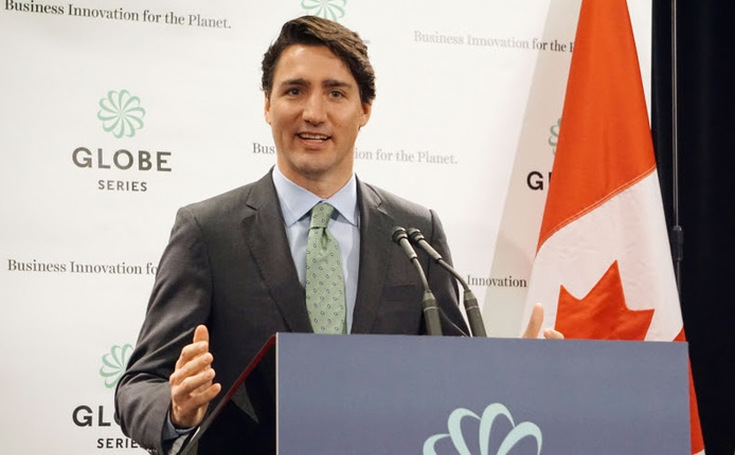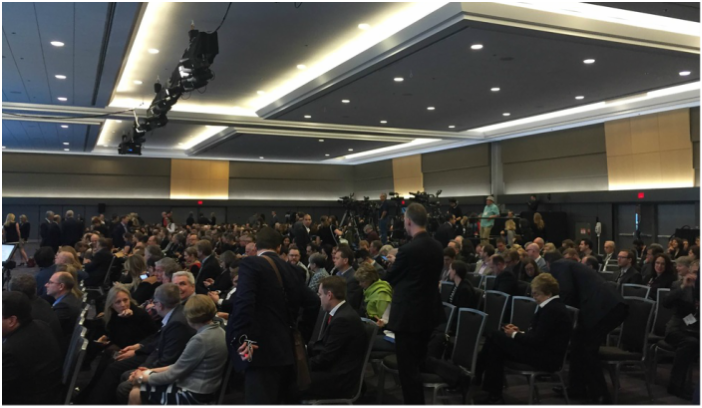Crowd Valley was invited to speak at the Globe Forum in Vancouver on enabling institutional capital deployment in the context climate change and the development of ‘green innovation’. Canada’s Prime Minister Justin Trudeau opened the event with an enthusiastic outlook on the opportunities at hand and a call to action, and several ministers, institutional funds and technology leaders participated in the keynote sessions, including Crowd Valley’s CEO Markus Lampinen.

Climate change is a crucial discussion point going on several years now and is becoming more central even in finance related discussions. As an example, Tim Loh, Bloomberg at this link, describes how JPMorgan, similar Morgan Stanley, Citigroup, Bank of America and Wells Fargo, won't finance new coal mines and will no longer give money to coal-fired power plants in some countries, in order to combat climate change.
In the Globe Forum session, the speakers covered how billions of funds are locked away in mandates, despite the demand to invest in technologies to combat climate change. Investment opportunities in sectors such as clean tech, solar, infrastructure, are out of reach because of the structure in place that prevents the participation in what can be considered smaller investment opportunities.
Small is of course relative and in this case, we are in fact talking about sub $500M investments. That’s the inability to allocate capital in deals under half a billion in ticket size! But let’s understand the problem before moving forward.
A large investor, e.g. a pension fund, has a mandate for long term investments, that is to safe guard people’s retirement funds and avoid unnecessary risks. This mandate directs how they make their investments, but further the entire process of their operations and activities around the investment. The cost of doing a particular investment is high, given the procedures, the cost of sourcing the deal, the deal diligence and vetting, the stakeholders involved and the qualification process. Furthermore, the cost is not proportional to do the investments size, it is relatively flat.
Why is particularly this last point relevant? If the cost per investment is not linked to the investment size, it means for each investment you are effectively paying the same cost. So the cost of making a $500M investment is the same as making a $50M investment. And further the same as making a $5M investment. To spell that out, to allocate $500M in $5M investments, would cost 100 times more than to allocate $500M in one single big ticket investment.
This is purely a look at cost structure, there are other factors at play too, such as later stage investments often having lower risk profiles, having been de-risked during the market roll out in its critical areas, all of which are key considerations for an institutional capital deployer with a stringent mandate.
In the Globe Forum session, the speakers covered how billions of funds are locked away in mandates, despite the demand to invest in technologies to combat climate change. Investment opportunities in sectors such as clean tech, solar, infrastructure, are out of reach because of the structure in place that prevents the participation in what can be considered smaller investment opportunities.
Small is of course relative and in this case, we are in fact talking about sub $500M investments. That’s the inability to allocate capital in deals under half a billion in ticket size! But let’s understand the problem before moving forward.
A large investor, e.g. a pension fund, has a mandate for long term investments, that is to safe guard people’s retirement funds and avoid unnecessary risks. This mandate directs how they make their investments, but further the entire process of their operations and activities around the investment. The cost of doing a particular investment is high, given the procedures, the cost of sourcing the deal, the deal diligence and vetting, the stakeholders involved and the qualification process. Furthermore, the cost is not proportional to do the investments size, it is relatively flat.
Why is particularly this last point relevant? If the cost per investment is not linked to the investment size, it means for each investment you are effectively paying the same cost. So the cost of making a $500M investment is the same as making a $50M investment. And further the same as making a $5M investment. To spell that out, to allocate $500M in $5M investments, would cost 100 times more than to allocate $500M in one single big ticket investment.
This is purely a look at cost structure, there are other factors at play too, such as later stage investments often having lower risk profiles, having been de-risked during the market roll out in its critical areas, all of which are key considerations for an institutional capital deployer with a stringent mandate.
How does digital finance fit into the picture?
With an inhibitive cost structure, the sheer efficiency digital finance applications bring can represent a significant opportunity. With new age tools efficiency can be introduced to deal sourcing, vetting, deal structuring, diligence, communication and allow larger funds to expand their operations by streamlining their operations. The impact can mean diversification into new underserved asset classes and access to deals that are smaller in size as opposed to the traditional investment opportunities.
Saving a few basis points in the deal making process can have a big impact, particularly in the context of large capital transactions and a very risk averse stakeholder group. The demand for more capital behind innovation to combat different aspects of climate change creates a clear impediment for larger capital to boost and scale new innovation and digital finance applications can be a key to unlocking future generation technology and deploying it worldwide.
The Globe Forum was an important gathering of key policy makers and institutional capital sources, none the least the stakeholders of the p80 group, and we at Crowd Valley remain optimistic on new innovation to come as large capital leverages opportunities created by efficient new technology in the global arena.

About the author - Alessandro Ravanetti
Alessandro is Co-founder & CMO of Crowd Valley. He has worked in the fintech industry, with marketplace investing and lending, since 2011. Has built and managed digital companies with distributed teams and international partners, and gained experience with both startups and large corporations, having worked with British Telecom, Bloomberg and the Grow VC Group.
Alessandro grew up in Italy, where he graduated with a B.A. in Economics at University of Parma, before to obtain a M.S. in Finance at Regent’s University London. He studied and worked in many different cities, including Munich, Geneva, London, Barcelona and Valencia. Genuinely passionate about financial technology and innovation, he loves to spend his spare time traveling and discovering new cultures. You can find him on Twitter at @aleravanetti.
Alessandro is Co-founder & CMO of Crowd Valley. He has worked in the fintech industry, with marketplace investing and lending, since 2011. Has built and managed digital companies with distributed teams and international partners, and gained experience with both startups and large corporations, having worked with British Telecom, Bloomberg and the Grow VC Group.
Alessandro grew up in Italy, where he graduated with a B.A. in Economics at University of Parma, before to obtain a M.S. in Finance at Regent’s University London. He studied and worked in many different cities, including Munich, Geneva, London, Barcelona and Valencia. Genuinely passionate about financial technology and innovation, he loves to spend his spare time traveling and discovering new cultures. You can find him on Twitter at @aleravanetti.



 RSS Feed
RSS Feed